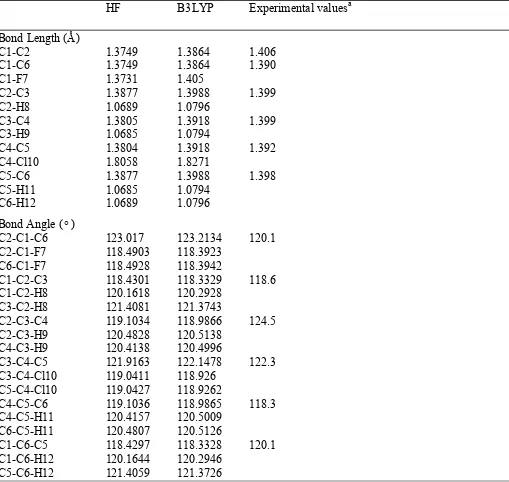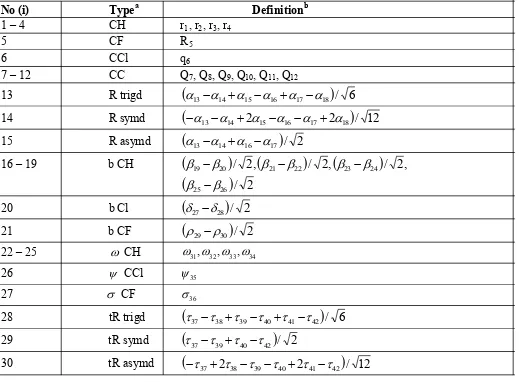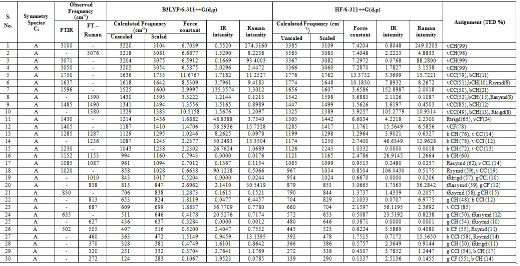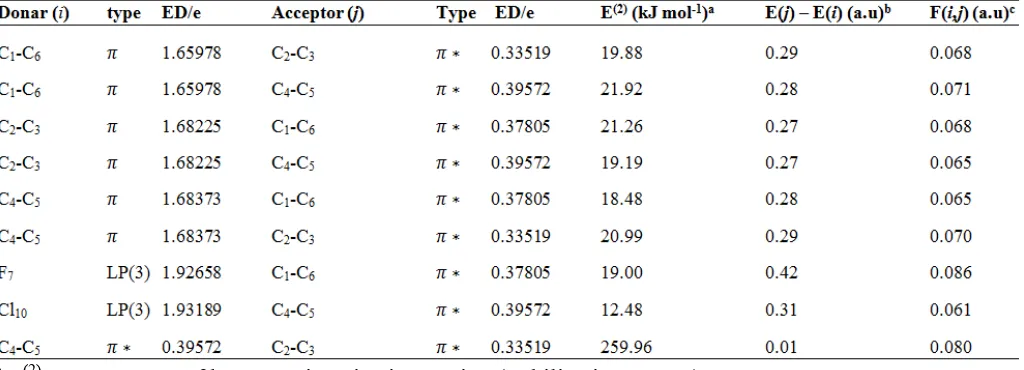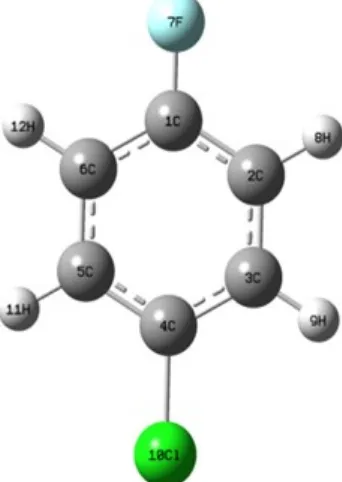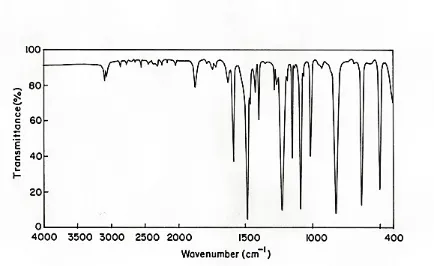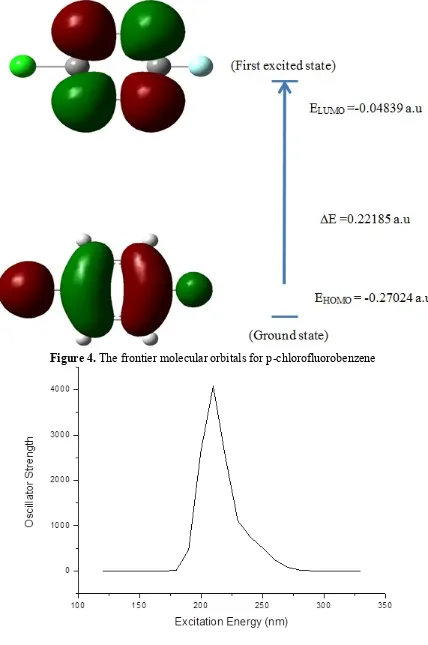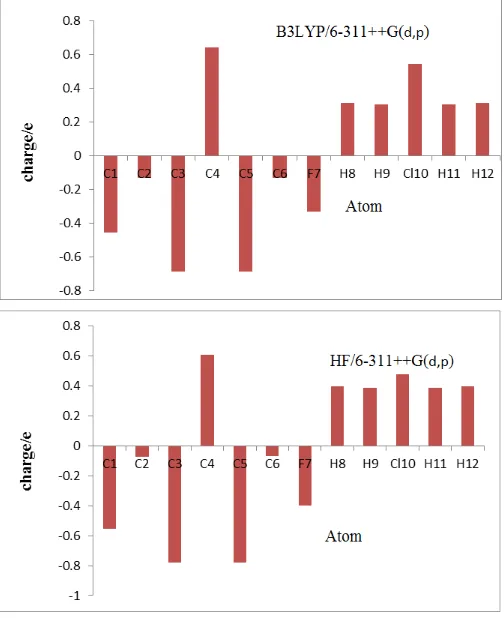IJSRSET1734107 | Received : 08 August 2017 | Accepted : 17 August - 2017 | July-August-2017 [(3)5: 434-448]
© 2017 IJSRSET | Volume 3 | Issue 5 | Print ISSN: 2395-1990 | Online ISSN : 2394-4099 Themed Section: Engineering and Technology
434
FTIR, FT-Raman Spectra, First-Order Hyperpolarizability, HOMO-LUMO,
NBO, and Mulliken Charge Analyses of p-Chlorofluorobenzene
M. Arivazhagan
*, G. John James
Department of Physics, Government Arts College, Tiruchirappalli, Tamilnadu, India
ABSTRACT
The FTIR and FT-Raman spectra of p-chlorofluorobenzene (P-CFB) have been recorded in the region 4000-400 cm
-1 and 3500-50 cm-1, respectively. The structural and spectroscopic data of the molecule in the ground state were
calculated by using density functional theory (DFT) employing B3LYP and ab initio Hartree Fock (HF) method with 6-311++G(d,p) basis set. The geometry of the molecule was fully optimized, vibrational spectra were calculated and fundamental vibration were assigned on the basis of potential energy distribution (TED) of the vibrational modes calculated with scaled quantum mechanical (SQM) method. The optimized structure of the title compound was interpreted and compared with the reported experimental values. The calculated HOMO-LUMO energy gap reveals that the charge transfer occurs within the molecule. Thermodynamic properties like entropy, thermal energy, zero point vibrational energy have been calculated for the molecule.
Keywords: FTIR; FT-Raman; p-chlorofluorobenzene; DFT; ab initio; HOMO-LUMO
I.
INTRODUCTION
Benzene is mainly used as an intermediate compound to make other chemicals, its mostly produced derivatives include styrene, which is used to make polymers and plastics. Benzene is a clear, colourless, no corrosive and highly flammable liquid with a sweet odour. It evaporates into the air very quickly and dissolves slightly in water. Benzene is also used to some type of rubbers, lubricant, dyes, detergents, drugs, and pesticides. Benzene is also a natural part of crude oil, gasoline [1]. Chlorobenzene is an important industrial solvent and widely used intermediate in production of commodities such as herbicides, dyestuffs, and rubber [2]. Fluorine is the most abundant halogen in the earth’s crust. However, only a dozen fluorinated organic compounds have been identified in nature. The incorporation of fluorine-containing groups into an organic molecule often drastically perturbs the chemical, physical and biological properties of the parent compound. The fluorinated compounds are widely used to medicinal, pharmaceutical, agricultural, and material sciences [3].
For proper understanding of IR and Raman spectra, several theoretical methods, ranging from semi
empirical to DFT approaches, are invaluable tools [4,5] and each method is having its own advantages. The Hartree-Fock ab initio method have to give good results provided a reasonable basis set, and an appropriate correlation treatment is taken into account. On the other hand, a powerful quantum chemical tool is used to give the electronic structure of the molecule has been evolved by B3LYP method [6]. The DFT method includes an electron correlation, in an alternative way to perform vibrational analysis of moderately large organic molecules. In the frame work of DFT approach, different from exchange and correlation functions are routinely used. Among these, the B3LYP combination is the most used, since it proved its ability in reproducing various molecular properties, including vibrational spectra.
(HF) and HOMO-LUMO, NBO analyses have been used to give more information regarding charge transfer within the molecules.
II.
METHODS AND MATERIAL
1. Experimental Details
The pure sample of p-chlorofluorobenzene was obtained from Lancaster chemical company, UK and used such as for spectral measurements. The FT-IR spectrum of the compound was recorded in the region 4000-400 cm-1
using the BRUKER IFS-66V FT-IR spectrometer equipped with an MCT detector, a KBr beam splitter and globar arc source. The spectral resolution is
1 cm-1.The FT-Raman spectrum of the sample was recorded between 3500-100 cm-1 using the BRUKER FRA 106 FT-Raman instrument using 1064 nm excitation from an Nd: YAG laser. The reported wave numbers are expected to be accurate within
1 cm-1.2. Computational details
In order to provide information with regard to the structural characteristics and the normal vibrational modes of P-CFB, the Hartree-Fock and DFT-B3LYP correlation functional calculations have been carried out. The entire calculations were performed using the GAUSSIAN 09W software package [7].
Initially, the HF level calculations, adopting the 6-311++G(d,p) basis set were carried out and then the DFT employing the Becke-3-Lee-Yang-Parr (B3LYP) supplemented with the standard basis set 6-311++G(d,p). The B3LYP is the most popular and efficient exchange correlation functional for calculating functional for calculating energies and geometries, it has been proven to be able to yield reliable results for small molecules [8]. All the parameters were allowed to relax and all the calculations converged to an optimized geometry which corresponds to a true minimum, as revealed by the lack of imaginary values in the wave number calculations. The Cartesian representation of the theoretical force constants has been computed at optimized geometry by assuming Cs point group symmetry. Scaling of the force
field was performed according to SQM procedure [9,10] using selective scaling in the natural internal coordinate representation [11,12]. Normal coordinate analysis was
performed to obtain full description of the molecular motion pertaining to the normal modes using MOLVIB program version 7.0 written by sundius [13,14].
3. Prediction of Raman intensities
The Raman activities (Si) calculated with GAUSSIAN
09W program are subsequently converted to relative Raman intensities (Ii) using the following relationship
derived from the basic theory of Raman scattering [15,16].
)
1
...(
...
...
...
exp
1
)
(
I
i i i 4 i 0 i
kT
hc
S
f
Where
0 is the exciting frequency in cm-1, i
is the vibrational wave number of ith normal mode; h, c and kare fundamental constants and f is a suitably chosen common normalization factor for all peak intensities.
III.
RESULTS AND DISCUSSION
3.1. Molecular geometry
3.2. Vibrational assignments
The molecule P-CFB belongs to Cs point group
symmetry, and it consists of 12 atoms its leads to 30 fundamental normal modes of vibrations are distributed among the symmetry species as:
6 3
N = 21A'(in-plane) + 9A''(out-of-plane)
The detailed vibrational assignments of fundamentals often made on the basis of the unscaled frequencies by assuming the observed frequencies, so that they are in the same order as the calculated ones. Then for an easier comparison of the observed values, the calculated frequencies are scaled by the scale to less than 1, to minimize the overall deviation. Therefore, we have used the different scaling factor values for HF/6-311++G(d,p) and B3LYP/6-311++G(d,p) methods. The result indicates that the B3LYP calculations approximate the observed fundamental frequencies much better than the HF results. The detailed vibrational assignment of fundamental modes of P-CFB along with the calculated IR and Raman frequencies and normal mode descriptions are reported in Table 4. The observed FTIR and FT-Raman spectra are shown in Fig. 2 and 3 respectively.
3.2.1. C-H Vibrations
The aromatic C-H stretching vibrations are normally found between 3100-3000 cm-1 [19]. The C-H stretching
vibrations of P-CFN are observed at 3100, 3071, 3050 cm-1 in IR spectrum and 3076 cm-1 in Raman spectrum.
The assigned values of C-H stretching vibrations are showed good agreement with the available literature data [20]. The C-H in plane bending vibrations are coupled with ring C-C stretching modes. The C-H in plane bending vibration of P-CFB appears at 1285, 1230, 1152 cm-1 in IR spectrum and 1287, 1236, 1153 cm-1 in
Raman spectrum and C-H out of plane bending vibrations are observed at 635 cm-1 in IR spectrum and
813, 627, 370 cm-1 in Raman spectrum.
3.2.2. C-Cl Vibrations
The vibration belonging to bond between the ring and the halogen atom was discussed here, since mixing of vibrations are possible due to lowering of molecular symmetry and the presence of heavy atoms on the periphery of molecule. The C-Cl absorption is obtained
normally between 850 and 550 cm-1 [21]. The C-Cl stretching mode vibration is found at 687 cm-1 in Raman
spectrum. The in-plane bending vibration is observed at 460 cm-1 in Raman spectrum. The C-Cl out of plane
bending vibration is observed at 320 cm-1 in Raman
spectrum. These are good agreement with the literature data [22].
3.2.3. C-F Vibrations
The C-F stretching mode vibrations are normally found between 1400-1000 cm-1 [23]. In the title molecule C-F stretching vibration found at 1405 cm-1 in IR spectrum.
The C-F in-plane bending vibration mode for the mono fluorinated benzene normally assigned at 250-350 cm-1
[24]. The C-F in-plane bending vibration of P-CFB is appeared at 502 cm-1 in IR spectrum and 505 cm-1 in
Raman spectrum. The C-F out of plane bending vibration observed at 272 cm-1 in Raman spectrum. The
reported values are good agreement with literature data [25].
3.2.4. C-C Vibrations
The bands between 1430 and 1650 cm-1 in the aromatic
and the heteroaromatic compounds are assigned to C-C stretching vibrations [26]. Accordingly, In the present investigation, the C-C stretching vibrations of P-CFB is observed at 1637, 1596, 1485 cm-1 in FT-IR and at 1590, 1490, 1380 cm-1 in FT-Raman spectrum. The C-C in
plane bending vibrations are observed at 1430, 1085, 1020 cm-1 in IR spectrum and 1087 cm-1 in Raman
spectrum. The C-C out of plane bending vibrations is observed at 830 cm-1 in IR spectrum and 1010, 838 cm-1
in Raman spectrum.
4. HOMO-LUMO Analysis
The HOMO and LUMO energy calculated by HF method with 6-311++G(d,p) basis set. The calculated values are shown in Table 5. This electronic transition absorption corresponds to the transition from the ground to the first excited state and is mainly described by an electron excitation from the HOMO to the LUMO. The atomic compositions of the frontier molecular orbital are shown in Fig 4.
An electronic system with a larger HOMO-LUMO gap should be less reactive than one having a smaller gap [29]. The HOMO-LUMO gap value of the title compound is 0.22185 a.u. The electron movement between these orbitals could easily occur so that we observe a peak value around in the UV-VIS spectrum, which is shown in Table 6. The calculated absorption spectrum of the title compound showed a high energy band gap, with a peak at 208.08 nm and a low energy band at 206.05 nm. The excited state lies at 5.1642 eV (240.08 nm). Electronic transition from the HOMO-LUMO are mainly derived from the electronic transition of
*. This is also confirmed by analysing theUV-Visible spectrum. The UV-Visible spectrum is shown in Fig 5. The computed excitation energies, oscillator strength and electronic transition configuration are shown in Table 6.
5. First Hyperpolarizability
The first hyperpolarizability (
0 ) of this novelmolecular system and related properties (
0,
0, and
) of P-CFB are calculated using B3LYP/6-311++G(d,p) basis set, based on finite field approach. First hyperpolarizability is third rank that can be described by 3x3x3 matrix. The 27 components of the 3D matrix can be reduced to 10 components due to the kleinman symmetry [30]. It can be given in the lower tetrahedral format. It is obvious that the lower part of the 3x3x3 matrices in the Taylor series expansion of the energy in the external electric filed. When the external electric field is weak and homogeneous of the expansion becomes
)
2
(
...
F
F
F
6
1
F
F
2
1
F
E
E
0
Where
E
0is the energy of unperturbed molecules,
F
is the field at the origin
,
and
are thecomponents of dipole moment, polarizability and the first hyperpolarizabilities, respectively. The total static dipole moment
, the mean polarizability
0 , the anisotropy of the polarizability
and the mean first hyperpolarizability
0 using the x, y, z components they are defined as:
21 2 2 2 z y
x
xx
yy
zz
3
1
0
21 2 2 2 2
6
2
1
xx xx zz zz yy yyxx
21 2 2 2
0
x
y
z
Andxzz xyy xxx
x
yzz xxy yyy
y
yyz xxz zzz
z
Since the value of mean polarizabilities and hyperpolarizability of the GAUSSIAN 09W output are reported in atomic units (a.u) and therefore, the calculated values have been converted into electrostatic units (esu) (1 a.u = 8.3693
10-33 esu) [31]. Theoretically calculated values of first hyperpolarizability and dipole moment are 0.171332x10-30 esu and -0.0365101 Debye. The reference value of urea is 0.37289
10-33 esu. The firsthyperpolarizability of the title compound is 0.45 times greater than that of urea.
6. Atomic charges
Mulliken atomic charge calculation has an important role in the application of quantum chemical calculation [32] to molecular system, because atomic charge affect dipole moment, polarizability, electronic structure and much more properties of molecular systems. The charge distributions calculated by Mulliken method for the equilibrium geometry of P-CFB are listed in Table 7. The corresponding, Mulliken plots are shown in Fig 6. Mulliken atomic charges p-chlorofluorobenzene have been calculated using B3LYP and HF method at 6-311++G(d,p) basis set. The calculated charges by HF are relatively lesser than B3LYP method. The atomic charge of C4 in p-chlorofluorobenzene is 0.641693 and
methods respectively. The maximum atomic charge is obtained for C4 when compare with other atoms.
6. NBO analysis
The natural bond orbital (NBO) calculations were performed using NBO 5.0 [33] program as implemented in the Gaussian 09 package at the DFT/6-311++G(d,p) level in order to understand various second order interactions between the filled orbitals of one subsystem and vacant orbitals of another subsystem, which is a measure of the delocalization or hyper conjugation. The hyper conjugative interaction energy was deduced from the second order perturbation approach [34].
2
,
2...
...
...
...
...
...
...
.(
3
)
i j i ij
j
i
F
q
E
E
Where
q
i is the donor orbital occupancy i and j are diagonal elements orbital energies and F(i,j) is the off diagonal NBO fock matrix element. The largerE
(2)value the move intensive is the interaction between electron donors and acceptors, i.e., the more donation tendency from electron donors to electron acceptor and the greater extent of conjugation of the whole system [35].
Delocalization of electron density between occupied lewis type (bond or lone pair) NBO orbital and formally unoccupied (antibond or Rydberg) non-lewis NBO orbital corresponds to a stabilizing donor-acceptor interaction.
The second-order perturbation theory analysis of fock matrix in NBO basis of P-CFB shows that strong intramolecular hyperconjugative interactions of
-electrons, which are depicted in the Table 8. Some electron donor orbital, acceptor orbital and the interacting stabilization energy resulting from the second-order micro-disturbance theory are reported.The intramolecular interactions due to the orbital overlap of
(C1-C6) with
* (C4-C5), resulting inhigh stabilization energy of 21.92 kcal/mol in P-CFB. The charge transfer from the lone pair of F7 to
anti-bonding C1-C6 amounts to stabilization energy of 19.00
kcal/mol in p-chlorofluorobenzene. The strong stabilization energy occurs 259.96 kcal/mol due to
*(C4-C5)
* (C2-C3) interaction. This highestinteraction around the ring can induce the large bioactivity of the molecule.
7. Other molecular properties
Several thermodynamic properties like zero point vibrational energy, rotational constants, rotational temperature, thermal energy, entropy, molar capacity at constant volume have been obtained by B3LYP and HF methods using 6-311++G(d,p) basis set. The obtained values are presented in Table 9.
IV.
CONCLUSION
The optimized geometries, harmonic vibrational wavenumbers and intensities of vibrational bands of p-chlorofluorobenzene have been carried out using the HF and B3LYP methods using the standard 6-311++G(d,p) basis set. This DFT based quantum mechanical approach provides the most reliable, theoretical information on the vibrational properties of p-chlorofluorobenzene. The difference between the observed and scaled wavenumber values of most of the fundamentals is very small. Any discrepancy noted between the observed and the calculated frequencies may be due to the fact that the calculations have been actually done on a single molecule in the gaseous state contrary to the experimental values recorded in the presence of intermolecular interactions. Therefore, the assignments made at higher levels of theory with only reasonable deviations from the experimental values seem to be correct. The TED calculation regarding the normal modes of vibration provides a strong support for the frequency assignment. The lowering of HOMO-LUMO energy gap explains the eventual charge transfer interactions taking place within the molecule. The thermodynamic, first-order hyperpolarizabilities and total dipole moment properties of the molecule have been calculated. The NBO analysis reveals that hyper conjugative interaction and stabilization of the molecule.
V.
REFERENCES
[1]. Arivazhagan, M.; Muniappan, P.; Meenakshi, R.;
Rajavel, G. Spectrochimica Acta Part A: Molecular and Biomolecular Spectroscopy, Volume 105 (2013), 497.
[2]. G. Shakila, S. Periandy, and S. Ramalingam,
1-Bromo-2-Chlorobenzene Using ab initio HF and Density Functional Theory (B3LYP) Calculations,” Journal of Atomic, Molecular, and Optical Physics, vol. 2011.
[3]. Xiu-Hua Xu, Kohei Matsuzaki, and Norio Shibata*
Chem. Rev., 2015, 115 (2), 731.
[4]. M. Castella - Ventura, E. Kassab, G. Buntinx, O. Poizat, Phys. Chem. Chem. Phys., 2(2000) 4682.
[5]. D.N. Shin, J.W. Hahn, K.H. Jung, T.K. Ha, J . Raman
Spectrosc., 29 (1998) 245.
[6]. S Jeyavijayan, M Arivazhagan - Indian Journal of Pure
and Applied Physics, 2012.
[7]. M.J. Frisch, G.W. Trucks, H.B. Schlegal, G.E.
Seuseria, M.A. Robb, J.R. Cheesman, V.G. Zakrzewsi, J.A. Mortgomerg Jr., R.E. Stratmann, J.C. Burant, S. Dapprich, J.M. Millam, A.D. Daniels, K.N. Kudin, M.C. Strain, O. Farkas, J. Tomasi, V. Barone, M. Cossi, R. Cammi, J. Mennucci, G.A. Petersson, P.Y. Ayala, Q. Cui, K. Morokuma, N. Rega, P. Salvador, J.J. Dannenberg, D.K. Malich, A.D. Rabuck, K. Raghavachari, J.B. Foresman, J. Cioslowski, J.V. Ortiz, A.G. Baboul, B.B. Stetanov, G. Liu, A. Liashenko, P. Piskorz, J. Komaromi, R. Gomperts, R.L. Martin, D.J. Fox, T. Keith, M.A. Al Laham, C.Y. Peng, A. Nanayakkara, M. Challacombe, P.M.W. Gill, B. Johnson, W. Chenp, M.W. Wong, J.L. Andres, C. Gonzalez, M. HeadGordon, E.S. Replogle, J.A. Pople, Gaussian 09, Revision A11.4, Gaussian, Inc., Pittsburgh, PA, 2009.
[8]. Y. Tao, L. Han, X. Li, Y. Han, et al., Molecular
structure, spectroscopy (FT-IR, FTRaman),
thermodynamic parameters, molecular electrostatic potential and HOMO-LUMO analysis of 2, 6-dichlorobenzamide, J. Mol. Struct. 1108 (2016) 307-314.
[9]. G. Rauhut, P. Pulay, J. Phys. Chem. 99 (1995) 3093.
[10]. P. Pulay, G. Fogarasi, G. Pongor, J.E. Boggs, A. Vargha, J. Am. Chem. Soc. 105(1983) 7037.
[11]. G. Fogarasi, P. Pulay, J.R. Durig (Eds.), Vibrational Spectra and Structure, Vol. 14, Elsevier, Amsterdam, 1985.
[12]. G. Fogarasi, X. Zhov, P.W. Taylor, P. Pulay, J. Am. Chem. Soc. 114 (1992) 8191.
[13]. (a) T. Sundius, J. Mol. Struct, 218 (1990) 321. (b) MOLVIB (V.7.0): Calculation ofHormonic Force Fields and Vibrational Modes of Molecules, QCPE program No.807(2002).
[14]. T. Sundius, Vib.Spectrosc. 29 (2002) 89.
[15]. P.L. Polavarapu, Journal of Physical Chemistry 94 (1990) 8112.
[16]. G. Kereztury, S. Holly, J. Varga, G. Besenyei, A.Y. Wang, J.R. Durig, Spectrochimica Acta 49A (1993) 2007.
[17]. G. Fogarasi, P. Pulay, J.R. Durig (Eds.), Vibrational Spectra and Structure, Vol. 14,Elsevier, Amsterdam, 1985.
[18]. G. Fogarasi, X. Zhov, P.W. Taylor, P. Pulay, J. Am. Chem. Soc. 114 (1992) 8191.
[19]. M. Arivazhagan, S. Jeyavijayan, Spectrochim. Acta A
79 (2011) 161.
[20]. D. Mahadevan, S. Periandy, S. Ramalingam,
Spectrochim. Acta A 79 (2011)962.
[21]. S. George, Infrared and Raman Characteristic Group Frequencies Tables andCharts, third ed., Wiley, Chichester, 2001.
[22]. N. Sundaraganesan, B. Anand, B. Dominic Joshua,
Spectrochim. Acta 65A(2006) 1053.
[23]. D. Mahadevan, S. Periandy, M. Karabacak, S.
Ramalingam, Spectrochimica Acta Part A82 (2011) 481.
[24]. M.S. Navti, M.A. Shashidar, Ind. J. Pure Appl. Phys. 668 (1994) 371–373.
[25]. N. Sundaraganesan, C. Meganathan, B. Domnic
Joshua, P. Mani, A. Jayaprakash,Spectrochim. Acta A 71 (2008) 1134.
[26]. R.K. Goel, S.D. Sharma, Indian J. Pure Appl. Phys. 19
(1981) 472.
[27]. M. Belletete, J.F. Morin, M. Leclerc, G. Durocher, J. Phys. Chem. A. 109 (2005)6953.
[28]. G. Gece, Corros. Sci. 50 (2008) 2981.
[29]. R. Kurtaran, S. Odabasoglu, A. Azizoglu, H. Kara, O.
Atakol, Polyhedron 26 (2007)5069.
[30]. D.A. Kleinman, Phys. Rev. 126 (1962) 1977.
[31]. K. Chaitanya, C. Santhamma, K.V. Prrasad, V.
Veeraiah, J. At. Mol. Sci. 3 (2012).
[32]. S. Gunasekaran, S. Kumaresan, R. Arunbalaji,
G.Anand, S. Srinivasan, J. Chem. Sci.120 (2008) 315. [33]. A.E. Reed, F. Weinhold, J. Chem. Phys. 83 (1985)
1736.
[34]. M. Szafran, A. Komasa, E.B. Adamska, J. Mol. Struct.
Theochem. 827 (2007) 101.
Table 1
Optimized geometrical parameters of p-chlorofluorobenzene computed at HF and B3LYP method with
6-311++G(d,p) basis set .
HF
B3LYP
Experimental values
aBond Length (
Å
)
C1-C2
1.3749
1.3864
1.406
C1-C6
1.3749
1.3864
1.390
C1-F7
1.3731
1.405
C2-C3
1.3877
1.3988
1.399
C2-H8
1.0689
1.0796
C3-C4
1.3805
1.3918
1.399
C3-H9
1.0685
1.0794
C4-C5
1.3804
1.3918
1.392
C4-Cl10
1.8058
1.8271
C5-C6
1.3877
1.3988
1.398
C5-H11
1.0685
1.0794
C6-H12
1.0689
1.0796
Bond Angle (
)
C2-C1-C6
123.017
123.2134
120.1
C2-C1-F7
118.4903
118.3923
C6-C1-F7
118.4928
118.3942
C1-C2-C3
118.4301
118.3329
118.6
C1-C2-H8
120.1618
120.2928
C3-C2-H8
121.4081
121.3743
C2-C3-C4
119.1034
118.9866
124.5
C2-C3-H9
120.4828
120.5138
C4-C3-H9
120.4138
120.4996
C3-C4-C5
121.9163
122.1478
122.3
C3-C4-Cl10
119.0411
118.926
C5-C4-Cl10
119.0427
118.9262
C4-C5-C6
119.1036
118.9865
118.3
C4-C5-H11
120.4157
120.5009
C6-C5-H11
120.4807
120.5126
C1-C6-C5
118.4297
118.3328
120.1
C1-C6-H12
120.1644
120.2946
C5-C6-H12
121.4059
121.3726
For numbering of atoms refer Fig.1
Table 2:
Definition of internal coordinates of p-chlorofluorobenzene.
No (i)
Symbol
Type
Definition
aStretching
1 – 4
r
iC – H
C2-H8, C3-H9, C5-H11, C6-H12
5
R
iC – F
C1-F7
6
q
iC – Cl
C4-Cl10
7 – 12
Q
iC – C
C1-C2, C2-C3, C3-C4, C4-C5, C5-C6, C6-C1
In - plane bending
13 – 18
iRing
C1-C2-C3, C2-C3-C4, C3-C4-C5,
C4-C5-C6, C5-C6-C1, C6-C1-C2
19 – 26
iCCH
C1-C2-H8, C3-C2-H8, C2-C3-H9, C4-C3-H9,
C4-C5-H11, C6-C5-H11, C5-C6-H12,
C1-C6-H12
27 – 28
iCCl
C3-C4-Cl10, C5-C4-Cl10
29 – 30
iCCF
C2-C1-F7, C6-C1-F7
Out - of - plane bending
31 – 34
iC – H
H8-C2-C1-C3, H9-C3-C2-C4,
H11-C5-C4-C6, H12-C6-C1-C5
35
iC – Cl
Cl10-C4-C3-C5
36
iC – F
F7-C1-C2-C6
Torsion
37 – 42
itring
C1-C2-C3-C4, C2-C3-C4-C5,
Table 3 :
Definition of local symmetry coordinates of p-chlorofluorobenzene.
No (i)
Type
aDefinition
b1 – 4
CH
r
1, r
2, r
3, r
45
CF
R
56
CCl
q
67 – 12
CC
Q
7, Q
8, Q
9, Q
10, Q
11, Q
1213
R trigd
13
14
15
16
17
18
/
6
14
R symd
13
14
2
15
16
17
2
18
/
12
15
R asymd
13
14
16
17
/
2
16 – 19 b CH
19
20
/
2
,
21
22
/
2
,
23
24
/
2
,
25
26
/
2
20 b Cl
27
28
/
2
21 b CF
29
30
/
2
22 – 25
CH
31,
32,
33,
3426
CCl
3527
CF
3628 tR trigd
37
38
39
40
41
42
/
6
29 tR symd
37
39
40
42
/
2
30 tR asymd
37
2
38
39
40
2
41
42
/
12
Table 4
The observed (FTIR and FT-Raman) and calculated (Unscaled and Scaled) frequencies, IR intensity,
Raman intensity and probable assignments (Characterized by TED) of p-chlorofluorobenzene using
B3LYP/6-311++G(d,p) and HF/6-311++G(d,p) methods and basis set.
Abbreviations: – stretching; b – bending; g – out-of-plane bending; t – torsion; R – ring; trigd – trigonal deformation; symd – symmetric deformation; asymd – antisymmetric deformation.
Table 5:
HOMO–LUMO energy gap of p-chlorofluorobenzene using B3LYP/6-311++G(d,p) method and basis set.
Parameter
Values (a.u)
HOMO energy
-0.27024
LUMO energy
-0.04839
HOMO – LUMO energy gap
E
0.22185
Table 6:
The computed excitation energies, oscillator strength and electronic transition configuration of
p-chloroflurobenzene.
Excited EE (eV)/ F Configuration CI expansion
state wavelength (nm)
coefficient
1
5.1642/240.08 0.0161 32
35
-0.33575
33
34
0.62153
2
5.9359/208.87 0.1003 32
34
0.30096
33
35
0.63377
3
6.0172/206.05 0.0006 33
36
0.67755
33
38 -0.15901
Atomic charge of p-chlorofluorobenzene using B3LYP/6-311++G(d,p) and
HF/6-311++G(d,p).
Atom number
Atomic charges
B3LYP
HF
C1
-0.455701
-0.554014
C2
-0.133070
-0.071075
C3
-0.687802
-0.780802
C4
0.641693
0.606013
C5
-0.687096
-0.779788
C6
-0.132314
-0.070248
F7
-0.331552
-0.399434
H8
0.314996
0.397856
H9
0.304304
0.388725
Cl10
0.547316
0.476274
H11
0.304245
0.388663
H12
0.314980
0.397831
Table 8
Second order perturbation theory analysis of Fock matrix in NBO basis corresponding to the
intramolecular bonds of p-chlorofluorobenzene.
a
E
(2)means energy of hyper conjugative interaction (stabilization energy).
bEnergy difference between donor and acceptor
i
and
j
NBO orbitals.
cF(
i
,
j
) is the Fock matrix element between
i
and
j
NBO orbitals.
Table 9:
Thermodynamic properties for p-chlorofluorobenzene obtained by HF and B3LYP method with
6-311++G(d,p) basis set.
Parameters
B3LYP
HF
Zero-point vibrational energy (kcal mol
-1)
51.82891
55.68314
Rotational Constants (GH
Z)
A
5.62413
5.73056
B
0.91812
0.93815
C
0.78928
0.80617
Rotational Temperature (kelvin)
D
0.26992
0.27502
E
0.04406
0.04502
F
0.03788
0.03869
Thermal Energy (kcal mol
-1)
Total
55.821
59.394
Translational
0.889
0.889
Rotational
0.889
0.889
Vibrational
54.044
57.617
Entropy (cal mol
-1kelvin)
Total
80.990
79.317
Translational
40.500
40.500
Rotational
28.758
28.696
Vibrational
11.733
10.121
Molar capacity at constant volume (cal mol
-1k
-1)
Total
24.018
22.078
Translational
2.981
2.981
Rotational
2.981
2.981
Vibrational
18.056
16.117
Figure 2.
FTIR Spectrum of p-chlorofluorobenzene
Figure 4.
The frontier molecular orbitals for p-chlorofluorobenzene
